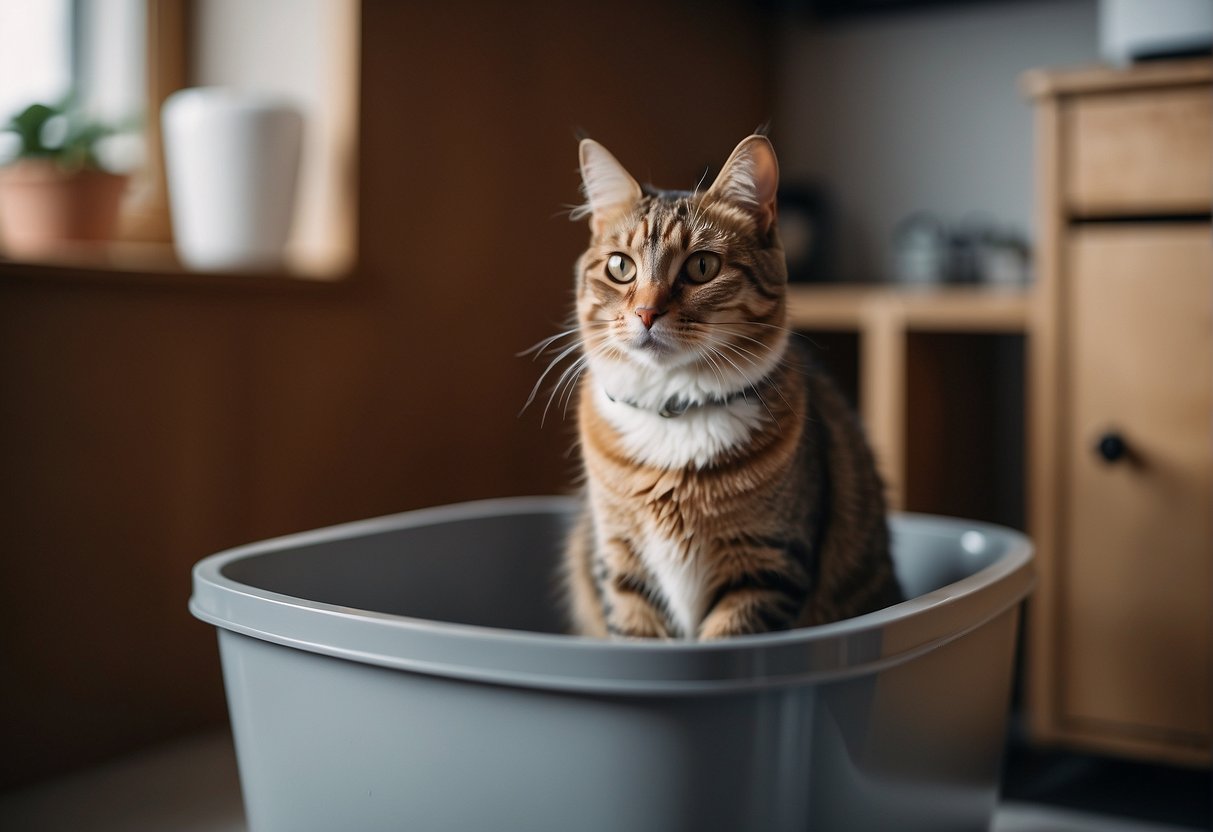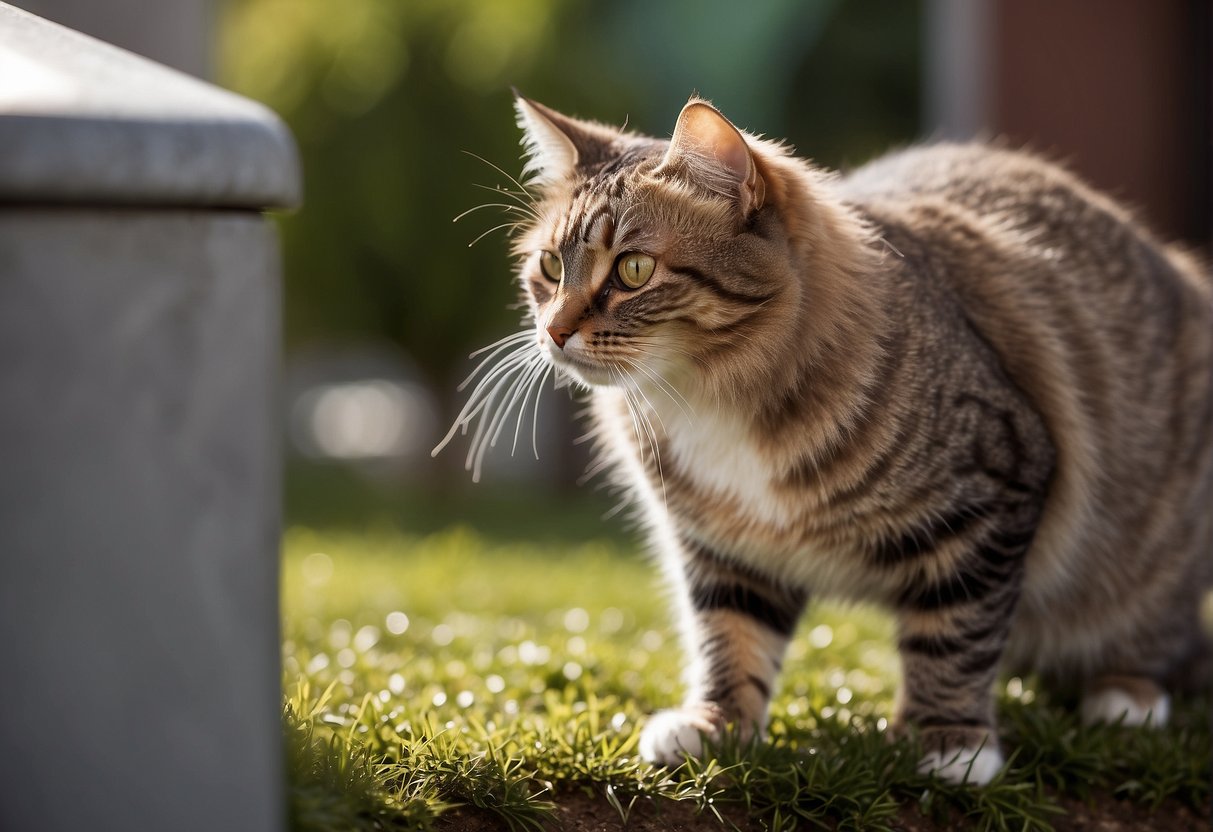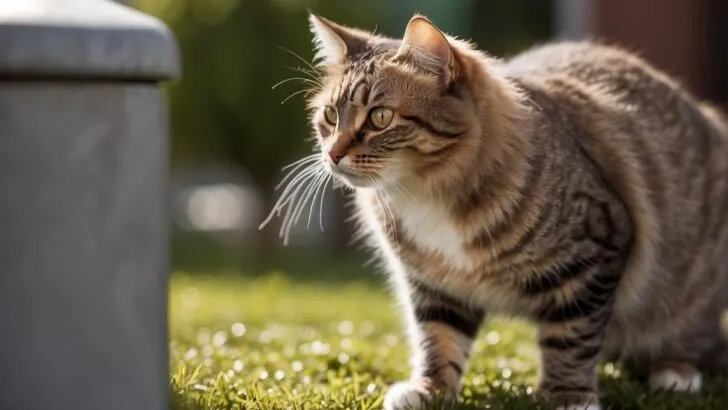Getting a cat to stop spraying can be a challenging task that requires understanding the behavior and addressing its underlying causes. If you’ve walked into a room to an unpleasant surprise on your favorite chair or seen your cat backing up to a wall with a telltale twitch of the tail, you’re not alone.
Cats spray for various reasons, from marking their territory to expressing stress or health issues. The scent-marking behavior is more common in unneutered male cats but can be seen in females and neutered males as well.

In my experience with cats, finding the trigger for this behavior is key to stopping it. It could be a new pet in the home or simply rearranging the furniture that sets off your feline friend.
One of my cats started spraying when I brought home a new set of dining chairs—a clear signal of his discomfort with the change. Another time, the arrival of a stray cat in the garden prompted a similar reaction.
Dealing with cat spraying means being a bit of a detective. It’s important to pay attention to when and where your cat sprays to get to the bottom of their behavior. It could be a medical issue like a urinary tract infection or something environmental, such as a new person in the house or even a new brand of litter.
Cat Spraying and Its Causes

When your feline friend begins spraying, it can be both perplexing and frustrating. Understanding why cats engage in this behavior is the first step to addressing it.
What Is Cat Spraying?
Cat spraying is a form of communication and territorial marking. Unlike regular urination, which is done in a squatting position to eliminate waste, spraying involves backing up to a vertical surface with a quivering tail and ejecting urine.
This is done by both male and female cats, and is more common in cats that are not neutered or spayed. The urine sprayed contains pheromones, which convey messages to other cats and mark territory.
Common Causes of Spraying
Several factors can lead to a cat starting to spray, including:
- Territoriality: Cats may spray to mark their territory, especially if they feel threatened by other cats.
- Stress and Anxiety: Changes in their environment, such as moving house or the introduction of new pets, can cause emotional distress.
- Medical Causes: It is important to rule out urinary tract infections or other medical issues with a vet visit.
- Behavioral Issues: Some cats spray due to underlying behavioral problems that may require professional training or therapy.
- Maturity: Intact males and females will spray as a part of behavior to attract mates.
Medical and Behavioral Assessment
Before addressing cat spraying, it’s essential to distinguish between medical issues and behavioral triggers. Identifying the cause will lead to more effective solutions.
When to Visit a Veterinarian
If you notice your cat has started spraying, a visit to the veterinarian is an important first step. This visit can help rule out or treat any underlying medical issues. Conditions such as urinary tract infections (UTIs) or lower urinary tract disease can cause discomfort and result in spraying. The vet may suggest a series of tests, including:
- Complete blood count (CBC)
- Urinalysis
- Chemistry panel
These tests can uncover any health concerns that might be contributing to your cat’s spraying behavior.
Behavioral Factors and Environmental Stressors
Once you’ve eliminated medical problems, it’s time to consider behavioral factors and environmental stressors. Cats are sensitive to changes in their environment, which can cause anxiety and lead to spraying as a form of territorial marking. Stress can be triggered by:
- New pets or people in the home
- Changes in your daily routine
- Loud noises or unfamiliar scents
Prevention and Management Strategies
When your cat starts spraying, it can be a frustrating experience, but there are practical steps you can take to prevent and manage this behavior. Ensuring a peaceful environment and proper health care are foundational to addressing spraying issues.
Creating a Cat-Friendly Environment
Creating a welcoming space for your cat is critical to preventing spraying. In your home, consider the environment from a cat’s perspective. Resources should be plentiful, especially in multi-cat households. Here are some essentials:
- Litter boxes: Have one more litter box than the number of cats in your household, and place them in quiet, accessible areas. Litter boxes should be kept clean as cats are averse to dirty environments, which could lead to spraying.
- Cat Trees and Scratching Posts: These provide climbing opportunities and areas where cats can mark with their claws instead of spraying.
- Food and Water Bowls: Each cat should have its own bowls to prevent conflict; this includes having them spaced apart to offer a feeling of security during mealtimes.
- Perches and Hiding Places: Cats feel safe when they have high places to observe their territory or hidden nooks for retreat.
Introduce pheromone diffusers in areas where your cat spends the most time to mimic calming pheromones and reduce stress-related spraying.
Importance of Neutering and Spaying
Neutering (for male cats) and spaying (for female cats) significantly decrease the likelihood of spraying. Hormones play a substantial role in this behavior, and by having your cat neutered or spayed, you can eliminate these hormonal urges.
- Neutered male cats are less likely to spray to mark their territory or attract a mate.
- Spayed or neutered cats in multi-cat households tend to be less aggressive and more at ease, which can reduce the tension that leads to spraying.
If you’re faced with spraying issues, these prevention and management strategies can be your roadmap to a happier, spray-free home.
Effective Cleaning and Odor Removal
When your cat sprays, quick and effective cleaning is crucial not just to keep your house smelling fresh, but also to discourage repeat offenses.
Dealing with Immediate Mess
First, blot the cat urine with paper towels or a clean cloth to absorb as much liquid as possible. Avoid rubbing the area, as this can cause the urine to penetrate deeper into the material. After blotting, apply an enzymatic cleaner designed for pet odors; these break down the urine molecules, eradicating the smell that draws cats back to the same spot.
It’s important to thoroughly soak the area and let it sit for the recommended time before blotting again.
- For carpets and upholstery: Gently press on the towels to soak up the urine, then follow with an enzymatic cleaner.
- For hard surfaces: Wipe clean, then use the enzymatic cleaner. Be attentive to crevices where urine could hide.
Long-Term Odor Management
For ongoing odor control, regular cleaning of the litter box is essential. Washing it weekly with soapy water and changing the litter frequently can prevent smells from lingering. For items like furniture, blinds, and curtains, regular laundering or steam cleaning can help.
- For furniture: Use covers that are easily washable and apply sprays that discourage your cat from marking.
- For blinds and curtains: Regularly wipe down with a mixture of water and vinegar or a pet-safe cleaner.
- Attention to detail makes a difference for horizontal and vertical surfaces. A clean, pleasant environment reduces the likelihood your cat will feel the need to spray.

My name is James, and welcome to FAQCats!
Along with our team of cat owners, expert pet enthusiasts, and pet professionals, we aim to write engaging helpful, engaging content about cats. At FAQCats we strive to provide content that’s accurate and fun to read. Our team writes about everything related to cats; even the most complex of topics. Through extensive research and caring for our own fur-pals, we’re able to provide something cat owners worldwide will love. Have a look around, and leave us feedback anytime!

